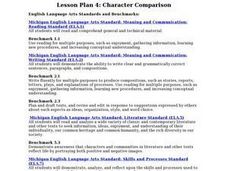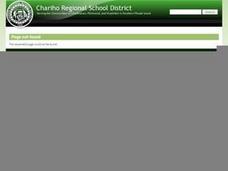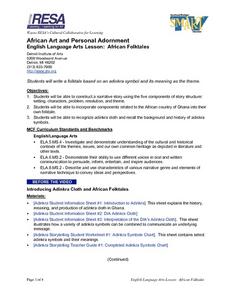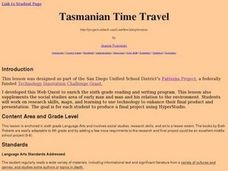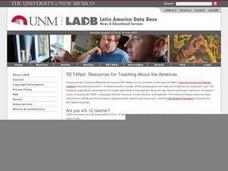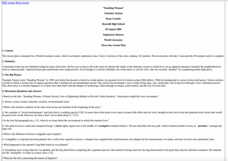Curated OER
Fables Unit Lesson Plan
Students study fables in a broad context. In this literary lesson on fables, students define terms unique to them. Students use a variety of technological resources to gather and classify information into three categories. Students also...
Curated OER
Finding Excellent Nonfiction in Long-form Journalism
How to find engaging, rigorous nonfiction texts through long-form journalism.
Curated OER
Character Comparison: Tales of a Fourth Grade Nothing
Fourth graders compare and contrast Fudge and Peter, two main characters from "Tales of a Fourth Grade Nothing". They use a software template to analyze and compare the characters in a rough draft, edit their work and then produce a...
Curated OER
What Difference Does it Make How Old I Am?
Students identify subtle messages advertisers send (often unintentionally) about age in the course of trying to sell products; to analyze the consequences, both positive and negative, those messages have on the American audience; to...
Curated OER
Blending Fiction and Nonfiction to Improve Comprehension and Writing Skills
Students explore a content area by reading both fiction and nonfiction texts on the topic. They do more research online about the topic. After comparing the texts, they create their own written original work, using both narrative and...
Curated OER
Cloudy With A Chance of Meatballs
Third graders read the book, Cloudy with a Chance of Meatballs." Using the internet, 3rd graders research weather conditions, plants, animals and foods from different countries. After sharing information, they discuss similarities and...
Curated OER
Fairytale Cake
Students recreate characters from the story, "The Fairytale Cake." In this fairy tale characterization lesson, students first listen to fairy tales read aloud. They then use play dough and plastic bowls as pretend "cakes and icing", and...
Curated OER
The Perfect Man: Benjamin Franklin's Autobiography
Eleventh graders study the characteristics of an autobiography. They read from the autobiography of Benjamin Franklin and discuss and write an essay regarding some of his quotes.
Curated OER
The Legend of Sleepy Hollow
Students research the American Revolution through the story of the Legend of Sleepy Hollow. In this American Revolution lesson, students research folktale and The Legend of Sleepy Hollow. Students view illustrations for the story....
Curated OER
Twenty-one Balloons
Fifth graders determine what the Newbery Award is and why it is importance. They examine a number of Newbery Award winning books and listen to a book talk about William Pene DuBois', Twenty-One Balloons while watching a PowerPoint...
Curated OER
How We Have Changed!
First graders practice using their writing skills. They create memory books through the use of daily journal writing questions of the day. Students respond to story prompts and write autobiographies of themselves and another classmate.
Curated OER
African Art and Personal Adornment: African Folktales
Students write a folktale based on an African adinkra symbol. They research its meaning and relate it as the theme.
Curated OER
Sequencing a Chinese Folktale
Students sequence the events of the popular Chinese folktale "The Terrible Nung Gwama" using a graphic organizer. This lesson takes 45-minutes and includes two possible enrichment activities.
Curated OER
Tasmanian Time Travel
Sixth graders perform research using the Internet about the Tasmanian Devil. The project can be presented in a variety of ways. The use of computer software is important for students to know, specifically Hyperstudio.
Curated OER
Editing Emily's Way: An Exercise in Diction and Its Implications
Learners examine the poetry of Emily Dickinson and the diction in her poetry. In this poetry analysis lesson, students read Dickinson poetry and analyze the diction in the poems. Learners journal about the poetry and rewrite their own...
Curated OER
In The Eye Of The Beholder
Learners, in groups, research Rembrandt's life and works. They find critiques of his work, as well. Each group reports their findings back to the rest of the class. Finally, they create abstract drawings and write interpretations about...
Curated OER
Publishing: A Persuasive Essay
Third graders are given an opportunity to create a visual to accompany their presentations of their persuasive essays. They may use the computer or other media as resources.
Curated OER
Lyddie
Seventh graders read the novel, Lyddie, while studying the reform movement. They complete assignments for each chapter and write essays about Lyddie's development through the novel.
Curated OER
Lessons from History
Students review key vocabulary in history and review a specific website. They write a paragraph summarizing an event they read about on this website. They analyze the importance of studying and learning from history.
Curated OER
Looking Through Lenses
Students explore the various societal and cultural "lenses" which color their perspectives and life experiences by reading the short story "What Means Switch" by Gish Jen. They discuss how the cultural ideas and beliefs affect the...
Curated OER
Electronic Journals about Latin American Folktales
Students exchange folktales with a key-pal using dialog journal writing. They write out a folktale from their own cultural background and exchange it with students of another. They record their impressions of each other's folktales.
Curated OER
Standing Woman
Students explore a Japanese science fiction story that deals with the dangers of technology, failed attempts at utopia, mind control, and loss of loved ones through the reading of Yasutaka Tsutaka's "Standing Woman."
Curated OER
"The Father of Lavish Advertising": P.T. Barnum
Students examine the life and work of P.T. Barnum. They discover his advertising techniques and business practices. They examine his use of people with disabilities for amusement.
Curated OER
Make Way for Ducklings
First graders use skills to collect, organize, and interpret data. They compare and contrast two stories, Make Way for Ducklings and Chibi: A True Story From Japan. Students create a duckling.




